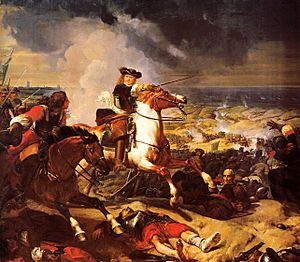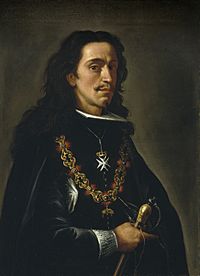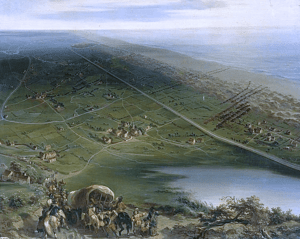Battle of the Dunes (1658) facts for kids
Quick facts for kids Battle of the Dunes |
|||||||
|---|---|---|---|---|---|---|---|
| Part of the Franco-Spanish War and Anglo-Spanish War (1654–1660) | |||||||
 La Bataille des Dunes, Charles-Philippe Larivière |
|||||||
|
|||||||
| Belligerents | |||||||
| Commanders and leaders | |||||||
| Strength | |||||||
| 14,000–15,000 (3,000 English troops) | 14,000–15,000(2,000 English Royalists) | ||||||
| Casualties and losses | |||||||
| 400 killed or wounded | 1,000–1,200 killed 3,000 wounded 5,000 captured |
||||||
The Battle of the Dunes happened on June 14, 1658. It took place near the important port city of Dunkirk. At that time, Dunkirk was part of the Spanish Netherlands.
This battle was a big part of two wars happening at the same time: the Franco-Spanish War and the Anglo-Spanish War. A French army, led by Turenne, was trying to capture Dunkirk. They were helped by soldiers from the Commonwealth of England.
A Spanish army, led by John of Austria the Younger and Louis, Grand Condé, tried to stop the French. They had help from English Royalists and French rebels. But the Spanish side lost badly.
Even though the French won, both France and Spain were very tired from the long war. They signed a peace treaty called the Treaty of the Pyrenees in November 1659. England kept Dunkirk until 1662. Then, Charles II sold the port back to France.
Contents
Why the Battle Happened
A Mix of Allies
The situation before the battle was quite complicated. Both French and English soldiers ended up fighting on different sides!
The French king, Louis XIV, made an alliance with Lord Protector Oliver Cromwell of England. Cromwell was the leader of the Commonwealth of England.
Meanwhile, the exiled English king, Charles II of England, made a deal with Philip IV of Spain. Charles II wanted to get his throne back. He set up his army in Bruges. Spain gave him some money, but not enough to form a very large army.
The Siege of Dunkirk
In 1657, Cromwell and Louis XIV renewed their alliance. England sent 6,000 soldiers and a fleet of ships to help the French army. The French army, with their English allies, started to besiege Dunkirk.
Dunkirk was a very important port for Spain. Many privateers (like legal pirates) used Dunkirk to attack English merchant ships. This caused a lot of trouble for England.
In May 1658, about 3,000 soldiers defended Dunkirk. An English fleet of 18 ships blocked the port. This stopped any supplies or extra soldiers from reaching the city by sea.
The Spanish army was surprised because they thought the French would attack a different city. They reacted too slowly. The area around Dunkirk was flooded by the people living there to make it harder for the French to attack. But Turenne, the French commander, kept going.
The Spanish Response
A Spanish army of about 15,000 men, led by Don John of Austria, moved to help Dunkirk. This army had two main parts:
- The Spanish Army of Flanders in the middle and on the right.
- A smaller group of French rebels (called the Fronde) on the left, led by Condé.
The Spanish army included soldiers from Spain, Germany, and Wallonia. There were also 2,000 English and Irish Royalists. These Royalists hoped to form an army big enough to invade England and bring Charles II back to power. Charles's brother, James, Duke of York, was one of their commanders.
Turenne left about 6,000 men to continue the siege of Dunkirk. He then marched out to meet the Spanish army. The battle happened on June 14, 1658. It's called the Battle of the Dunes because the Spanish army lined up on a series of sand dunes near the sea.
The English "red-coats" (soldiers in red uniforms) from Cromwell's New Model Army fought very bravely. They charged up a sand-hill about 150 feet high. This surprised both armies because of how fiercely they attacked.
The Battle Begins
Setting the Scene
The Spanish army camped on the sand dunes northeast of Dunkirk. Turenne decided to attack them the very next day.
The French army had about 6,000 foot soldiers, 8,000 horse soldiers (cavalry), and 10 cannons. They lined up with their left side near the sea and their right side near a canal.
Turenne planned to use the low tide to his advantage. He put his cavalry on the left flank, near the beach. When the tide went out, it would expose the Spanish right side to his cavalry. He also placed 5 cannons on his right side and 5 cannons on his left side along the beach.
Cromwell's English troops, led by Major General Thomas Morgan and William Lockhart, faced the Spanish soldiers. The middle of the French army had French infantry, including the Guards and Swiss soldiers. The French cavalry on the right, led by the Duke de Crequi, faced Condé's forces.
The Spanish army had 6,000 foot soldiers and 9,000 horse soldiers. Their right side was on the sea, stretching across the sand-hills to the Furnes canal on their left.
- The regular Spanish infantry were on the right, led by Don Juan.
- The English Royalist regiments, led by the Duke of York, were to their left.
- The Walloon and German soldiers were in the middle.
- The French rebel Frondeurs and other troops were on the left.
The Spanish cavalry was behind their foot soldiers. The Spanish had rushed to help Dunkirk and left their cannons behind.
The Fight
Turenne started the battle with several cannon shots from his two batteries. The English fleet also fired some shots at the Spanish right side from their ships.
The Anglo-French army began to move forward. Cromwell's English troops quickly pushed ahead. They attacked a Spanish group of soldiers (called a tercio) that was on a sand dune, a bit ahead of the rest of the Spanish army. The English charged, fighting with their pikes, and pushed the Spanish down the hill.
As the English followed, their formation became exposed. James, Duke of York, led two cavalry charges against the English troops' side. Some Spanish cavalry from their reserves also attacked the English, but French cavalry defeated them.
The French infantry in the center advanced and met little resistance. Marshal Turenne used the receding tide to move most of his cavalry to his left side. This allowed them to surround the Spanish right wing.
On the Spanish left, Condé managed to hold off the first French attacks. He even counterattacked, but he was eventually forced to leave the battlefield. The German and Walloon soldiers in the center retreated when the French infantry attacked. This caused confusion among the Spanish cavalry, and they also fled.
The battle lasted about two hours. By noon, Turenne had won a complete victory. The Spanish forces were completely defeated.
Who Won and What They Lost
The Spanish lost about 1,200 soldiers killed, 3,000 wounded, and about 5,000 captured. The French lost only about 400 soldiers, and about half of those were English.
Among Cromwell's English troops, Lockhart's regiment fought the hardest. Their lieutenant-colonel and two captains were killed. Almost all their other officers were wounded. They also lost about 40 or 50 other soldiers. Other English regiments had fewer losses.
The French chased the fleeing Spanish forces until nightfall. One group of English Royalist guards held out. They only surrendered when they were promised they could rejoin Charles II. The Duke of York's guards, who charged many times with the Duke leading them, also suffered heavy losses but were still able to fight later.
After the Battle
Taking More Land
After his victory, Turenne captured Dunkirk. Then, he continued to take more towns and fortresses. These included Furnes, Dixmunde, Gravelines, Ypres, and Oudenarde.
The victory at the Battle of the Dunes helped bring an end to ten years of war. This led to the signing of the Treaty of the Pyrenees in 1659.
By this treaty, France gained new lands from Spain. These included Roussillon and Perpignan, Thionville, Montmédy, and other parts of Luxembourg and Artois. Towns like Arras, Béthune, and Gravelines also became French. A new border between France and Spain was set at the Pyrenees mountains. The treaty also made Spain recognize all the lands France had gained in the 1648 Peace of Westphalia.
Dunkirk's Fate
The defeat of the Spanish army and the capture of Dunkirk meant that Charles II's plan to invade England was stopped for a while. Dunkirk surrendered to the French ten days after the battle, on June 24.
Cardinal Mazarin, a French leader, kept his promise to Oliver Cromwell. He handed the port of Dunkirk over to the Commonwealth of England.
The English soldiers didn't stop fighting after Dunkirk. Some stayed to guard Dunkirk and Mardyke. The rest continued to fight with Turenne's army.
England got rid of Spain's biggest privateering base. This meant that English merchant ships were much safer.
Cromwell died two months after the battle. His son took over, but his rule ended nine months later. The Commonwealth fell into confusion, and Charles II returned to the throne in May 1660. In 1662, Charles sold Dunkirk back to the French for £320,000.
English Soldiers in the Battle
Some famous British army regiments can trace their history back to this time.
- The Grenadier Guards started as Lord Wentworth's Royal Regiment of Guards in 1656.
- The Life Guards started as two cavalry troops: His Majesty's Own Troop of Horse Guards and The Duke of York's Troop of Horse Guards.
In the Spanish army, the English and Irish Royalists had three groups of soldiers. These groups were made of five regiments that were not at full strength.
- The first group included Lord Bristol's regiment and Lord Wentworth's regiment (also known as King Charles II's footguards).
- The second group was Lord Muskerry's and included the Duke of York's regiment.
- The third group had Lord Ormond's Irish regiment and Lord Newburgh's Scottish regiment.
In the French army, the English New Model Army regiments were on the left side (by the coast). They were named after their colonels: Cochrane, Alsop, Lillingston, and Morgan. On the right, there were 200 Montgommery musketeers. The cavalry included Lockhart, Gibbons, and Salmo.
Two of the three Royalist groups, Bristol's and York's Irish, broke and ran away during the battle.
See also
 In Spanish: Batalla de las Dunas (1658) para niños
In Spanish: Batalla de las Dunas (1658) para niños
- Henry Jones of Oxfordshire#Battle of the Dunes




